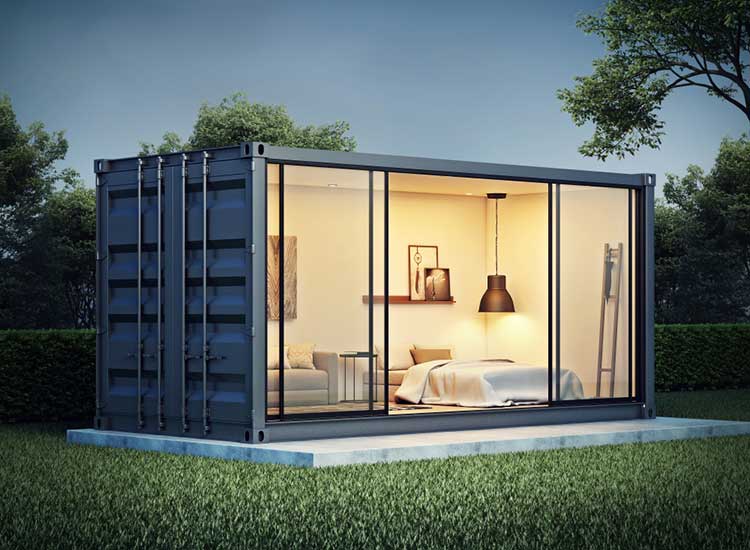Building with shipping containers
Building with shipping containers can be a great way to reduce your costs. However, the project can turn out to be expensive if you don’t know what you’re doing. Here are some mistakes to avoid when building with shipping containers, along with tips to make the process smoother.
Shipping containers were used creatively during the Coronavirus pandemic, but people had been using them to build houses much before that. However, while building with these versatile units might seem like a cost-effective option, there are certain mistakes you need to avoid when building with shipping containers.
This is why we have put together some tips for you, to help you get your house built quickly and without any unnecessary expenses.

What You Need for Building with Shipping Containers
A lot of people think that building a house out of a shipping container is just a matter of cutting out doors and windows. If only it were that simple!
As with any other construction project, building with these containers requires careful planning and strategic decision-making. There are plenty of points that could trip you up if you aren’t aware of them. These could then add to your project cost, making it as expensive as a traditional house.
Here are the things you need to be aware of when building with shipping containers.
Planning permissions
In general, building with a shipping container wouldn’t require planning permission as it is technically a temporary structure not fixed to the ground or a foundation. You may, however, want to check with your local authorities, just in case. It’s better to enquire and find out that you don’t need it than to go ahead without one and find out later that you do need it.
Of course, you shouldn’t have any problems getting the permission, if you do need it, as long as it’s not going to be located in a busy residential area or an Area of Outstanding Beauty. But, it is something you need to be aware of and prepared for.
Building Design
Building with a shipping container might seem easy enough to go ahead with without proper planning. Surely, it’s as simple as putting the container where you want it to be and cutting out a few holes for walls and doors, isn’t it?
The truth is, while much simpler than building conventional buildings, you still need to plan your shipping container house design in advance. This is especially true if you’re going to be using more than one container.
Firstly, even though shipping containers are quite strong structurally, they lose strength with every hole you cut out. This means that the more windows you want, the more the structure will need to be reinforced. If not planned properly, reinforcing might end up costing you enough to make the project very expensive.
Secondly, you will need to plan out electricals and plumbing, especially with stacked container homes. It is easier to cut out holes for wires and pipes before the containers are put on top of each other. Therefore, you’ll need to know beforehand where your wiring and plumbing will go.
Insulation
In essence, shipping containers are large metal boxes. They may be built to withstand force and the elements, but they heat up when it’s warm and can get quite cold when the surrounding temperature drops. This means they can be quite uncomfortable to live in during hot summers and cold winters.
Also, when they get cold, you get condensation, which could lead to the steel rusting and your home becoming damp and mouldy.
This is why one of our tips for building with shipping containers is to remember to insulate. The best insulation is spray foam insulation as it sticks to the corrugated surface of your container evenly.
However, another thing to bear in mind with insulation is that it is thick. If you have your insulation inside the container, it will end up making your interior space that much smaller. If used outside, however, you will have to make sure it is protected from the elements.
Container Specs
Before you rush to buy your shipping containers to build with, know what’s available. The standard containers are available in lengths of 20’ and 40’, with a height of 8’, but you can also get other specs, like high cube containers.
If you know what you need from your shipping container home, you can buy the specifications that suit your needs.
Another tip for when building with shipping containers is your choice of new or used containers. New containers are in better shape than used ones but can be much more expensive. A reasonable compromise might be to use a one-trip container, which is cheaper than new and in better shape than an often-used one.
Chemicals and Treatments
When building with shipping containers, it is important to remember these items are designed to transport heavy goods across water. This means that they are strong and weatherproof, but they are this way because they’ve been treated to be so.
These containers are normally treated with paint that is resistant to saltwater and adverse weather conditions. Also, the wooden floor is treated with chemicals to prevent rats and other pests from getting in.
Unless it was a food-grade container, you may need to strip the paint and change the flooring in order to keep yourself safe from the effects of strong chemicals.
Source of Containers
You can buy your shipping containers from a local supplier or a national chain. Both have their advantages and disadvantages. You can get a better selection to choose from with a national supplier and they will deliver anywhere in the country.
However, if you are planning to use a shipping container to build a home, it’s probably because you care about the environment and wish to recycle. In which case, you might want to think about the carbon footprint of transporting the container. Local suppliers will also have their stock near you, so your delivery won’t have to travel very far. This will also allow you to inspect the shipping containers before you buy them.
As local shipping container suppliers of Hampshire and the surrounding area, we are in a great position to supply you with used shipping containers, temporary site accommodation, and much more. Get in touch with us to learn more.




